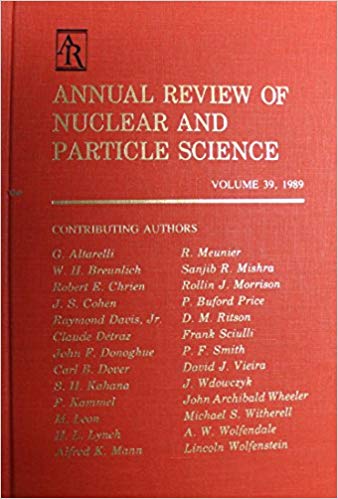Long-Term Multidimensional Models of Core-Collapse Supernovae: Progress and Challenges
IF 8.4
2区 物理与天体物理
Q1 PHYSICS, NUCLEAR
Annual Review of Nuclear and Particle Science
Pub Date : 2025-06-27
DOI:10.1146/annurev-nucl-121423-100945
引用次数: 0
Abstract
Self-consistent, multidimensional core-collapse (CC) supernova (SN) simulations, especially in three dimensions, have achieved tremendous progress over the past 10 years. They are now able to follow the entire evolution from CC through bounce, neutrino-triggered shock revival, and shock breakout at the stellar surface to the electromagnetic SN outburst and the subsequent SN remnant phase. Thus they provide general support for the neutrino-driven explosion mechanism by reproducing observed SN energies, neutron star (NS) kicks, and diagnostically relevant radioactive isotope yields. They also allow prediction of neutrino and gravitational wave signals for many seconds of proto-NS cooling, confirm correlations between explosion and progenitor or remnant properties already expected from previous spherically symmetric (one-dimensional) and two-dimensional models, and carve out various scenarios for stellar-mass black hole (BH) formation. Despite these successes, it is currently unclear which stars explode or form BHs because different modeling approaches disagree and suggest the possible importance of the three-dimensional nature of the progenitors and of magnetic fields. The role of neutrino flavor conversion in SN cores needs to be better understood, the nuclear equation of state (including potential phase transitions) implies major uncertainties, the SN 1987A neutrino measurements raise new puzzles, and tracing a possible correlation of NS spins and kicks requires still more refined SN simulations.核心坍缩超新星的长期多维模型:进展与挑战
自洽、多维核坍缩(CC)超新星(SN)的模拟,特别是在三维空间的模拟,在过去10年中取得了巨大的进展。他们现在能够跟踪从CC到反弹,中微子触发的激波复苏,恒星表面的激波爆发,到电磁SN爆发和随后的SN残余阶段的整个演化过程。因此,他们通过再现观测到的SN能量、中子星(NS)踢动和诊断相关的放射性同位素产量,为中微子驱动爆炸机制提供了一般支持。它们还可以预测中微子和引力波信号在许多秒的原始ns冷却过程中,确认爆炸与祖先或残余属性之间的相关性,这些属性已经从以前的球对称(一维)和二维模型中得到了预测,并为恒星质量黑洞(BH)的形成创造了各种场景。尽管取得了这些成功,但目前尚不清楚哪些恒星会爆炸或形成黑洞,因为不同的建模方法不一致,并且表明了祖恒星和磁场的三维性质可能的重要性。中微子风味转换在SN核中的作用需要更好地理解,核状态方程(包括潜在的相变)意味着主要的不确定性,SN 1987A中微子测量提出了新的难题,追踪NS自旋和踢动的可能相关性需要更精细的SN模拟。
本文章由计算机程序翻译,如有差异,请以英文原文为准。
求助全文
约1分钟内获得全文
求助全文
来源期刊
CiteScore
21.50
自引率
0.80%
发文量
18
期刊介绍:
The Annual Review of Nuclear and Particle Science is a publication that has been available since 1952. It focuses on various aspects of nuclear and particle science, including both theoretical and experimental developments. The journal covers topics such as nuclear structure, heavy ion interactions, oscillations observed in solar and atmospheric neutrinos, the physics of heavy quarks, the impact of particle and nuclear physics on astroparticle physics, and recent advancements in accelerator design and instrumentation.
One significant recent change in the journal is the conversion of its current volume from gated to open access. This conversion was made possible through Annual Reviews' Subscribe to Open program. As a result, all articles published in the current volume are now freely available to the public under a CC BY license. This change allows for greater accessibility and dissemination of research in the field of nuclear and particle science.

 求助内容:
求助内容: 应助结果提醒方式:
应助结果提醒方式:


